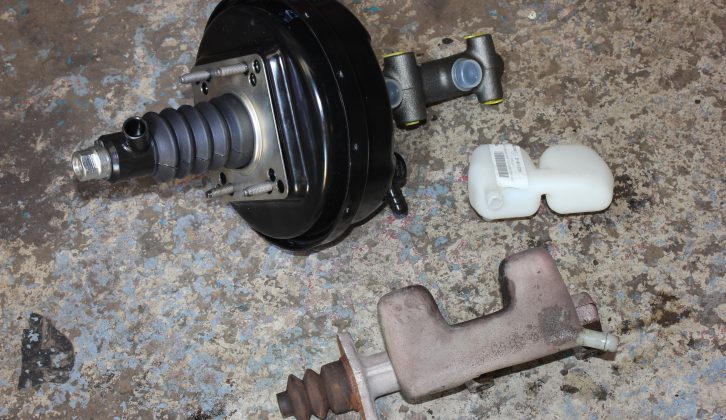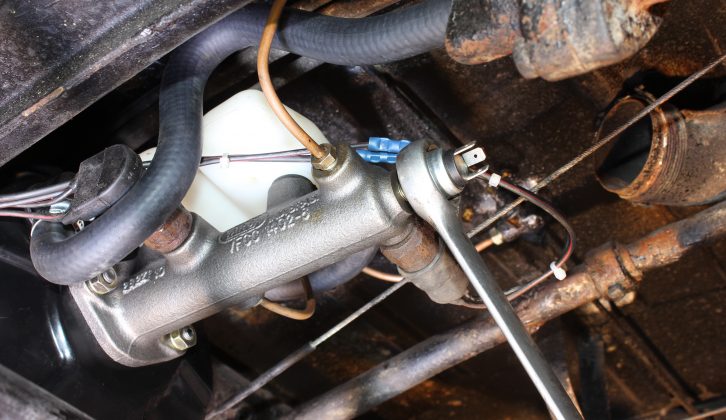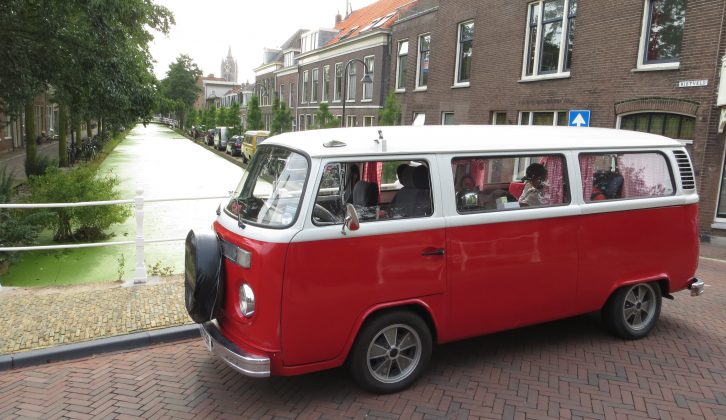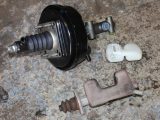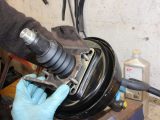Does your Bay Window campervan need better brakes? Then follow our Bay Window brake servo conversion guide, brought to you by DIY owner and VW campervan enthusiast Rob Hawkins.
Rob’s the proud owned of this very lovely red campervan, a 1976 VW Transporter, which was originally a German post office minibus (or microbus), which his kids have named Bertie. Since buying it in 2010 from Herbie Hospital with no interior and tatty white paintwork, he’s helped to respray it and has made all the interior himself. However, the best modification, he thinks, is this brake servo conversion. Travelling through Europe this summer, four up and with four bikes on board, the ‘van never missed a beat and he felt the brakes were as responsive as those on a modern vehicle. Inspired? Read on!
If you have a standard pair of disc brakes on the front of your VW Type 2 Bay Window camper, but no servo assistance, then you may find they require a heavy stamp on the brake pedal to get them to respond, especially when you need to stop quickly. Volkswagen fitted a brake servo on later Bays, so for anyone with earlier non-servo assisted disc brakes, a servo conversion is available.
A brake servo won’t improve the performance of your campervan’s brakes, but it will mean you don’t need to push quite as hard on the brake pedal. We’ve tested this on a Bay Window camper before and after the conversion and have found the servo assistance is a vast improvement with much less braking effort required.
Here we are going to tell you how to do it. However, fitting a brake servo to a Bay Window campervan is time consuming. Set aside a long weekend and be prepared to do some grinding, welding and fabricating.
First, you need to assemble the following tools:
- Angle grinder with cutting and grinding discs
- Brake pipe spanner
- Electric drill and drill bits
- File or die grinder
- Hammer and chisel
- MIG welder
- Screwdrivers
- Spanners/sockets – 7-24mm
- Trolley jack and axle stands
You’ll also need these parts from VW Heritage:
- Varga Brake servo with master cylinder (211612103GC)
- Steel vacuum pipe (211611793B)
- Servo to steel pipe vacuum pipe (211611939)
- Rear vacuum pipe from steel pipe (211611939A)
- Engine bay vacuum pipe (211611931)
- One way/non-return valve (191611933)
- Brake light switch blanking plug (214611225)
In addition, make sure you have DOT 4 brake fluid, jubilee clips, four M6 nuts and washers, an M12 high tensile or M14 fine threaded bar and two nuts, and a secondhand brake servo mounting bracket.
Ready? Right, let’s get stuck in.
Remove the old brake master cylinder
A good starting point is to remove the old brake master cylinder, which can be found underneath the vehicle and is secured with a couple of 13mm nuts and bolts. The pipework and electrical connectors will need detaching from it, allowing you to drain out some of the brake fluid. The brake pipes usually need to be shortened, so they are worth removing at this point.
The end of the brake master cylinder is connected to a rod, which is in turn attached to the bottom of the brake pedal. Detach the rod from the bottom of the brake pedal before removing the brake master cylinder.
Reservoirs
Remove the old brake fluid reservoir inside the cab to be able to change the pipe from it for a longer one (roughly 40cm) before refitting it. A new reservoir is supplied with the servo and may need to be fitted to it.
Mounting brackets
An original servo mounting bracket will be required, which is fitted between the upper and lower front beams. This can be purchased from a VW breakers if you don’t have one already. A second, thinner mounting bracket is included with the brake servo. The two brackets need to be welded together, but first, fit the two of them together on the servo and between the front beams. They probably won’t fit flush, so enlarge the holes and trim the edges so the two brackets fit together.
The centre hole in the new bracket has a lip on it, which must sit inside the same hole in the old mounting bracket – the hole in the old bracket may need to be enlarged. When you are satisfied the two mounting brackets fit together and the servo can be mounted to them, weld the two brackets together (do not weld them to the servo).
Make a brake pedal rod
The old rod that fitted between the bottom of the brake pedal and the original brake master cylinder isn’t long enough to be reused, but the end of it that attaches to the bottom of the brake pedal can be unscrewed and used again.
The end of the servo has an M14 fine thread attachment. If you can source a length of M14 fine threaded bar to fit, this can be used for the new rod. Otherwise, buy a length of M12 high tensile threaded bar and weld an M12 nut onto the end of the servo – you will need to remove the rubber boot, located with a circlip, to avoid burning it. This will enable the M12 threaded bar to be attached.
Whether you use an M12 or M14 threaded bar, temporarily fit the mounting bracket and servo between the front beams so you can measure the distance from the end of the servo to the bottom of the brake pedal. The threaded bar needs to be cut to this length, but don’t forget the clevis pin attachment for the bottom of the brake pedal (removed from the old rod). This has to be welded onto the end of the threaded bar.
Weld on the brackets
Trial fit the mounting brackets and servo with its threaded bar. Find the correct location between the front beams for the mounting brackets, then mark their location to be able to weld them in position. The servo can now be permanently fitted with M6 nuts and washers.
Vacuum outlet and pipes
Take a look at the inlet manifold to see if it has a vacuum outlet. If it doesn’t, it will need to be removed and an outlet fitted by drilling a suitable hole. Once there is an outlet, you can now fit all the pipework between it and the servo, including a one-way valve. Made to measure parts are available.
Brake pipes and switches
Reconnect the brake lines to the new servo (they may need to be shortened), along with the electrical connectors for the brake light switch(es). Any unused outlets for brake light switches can be plugged (see the parts list, above). Connect the pipe from the upper reservoir to the reservoir on the top of the servo. Top up the brake fluid and bleed the brakes, then test them, ensuring the brake pedal is consistently firm.
And there you are, you’ve done it!
The best modification he's made to this campervan, Rob thinks, is this brake servo conversion

